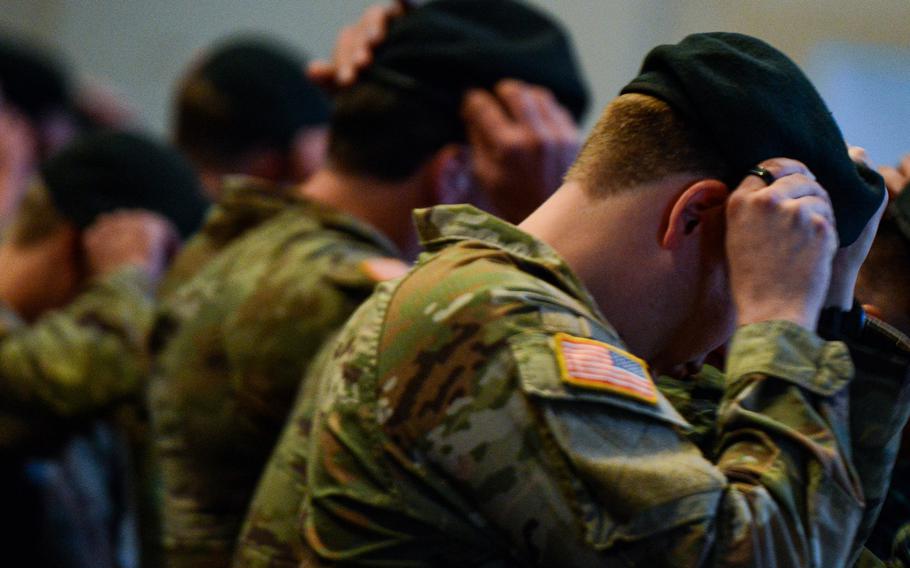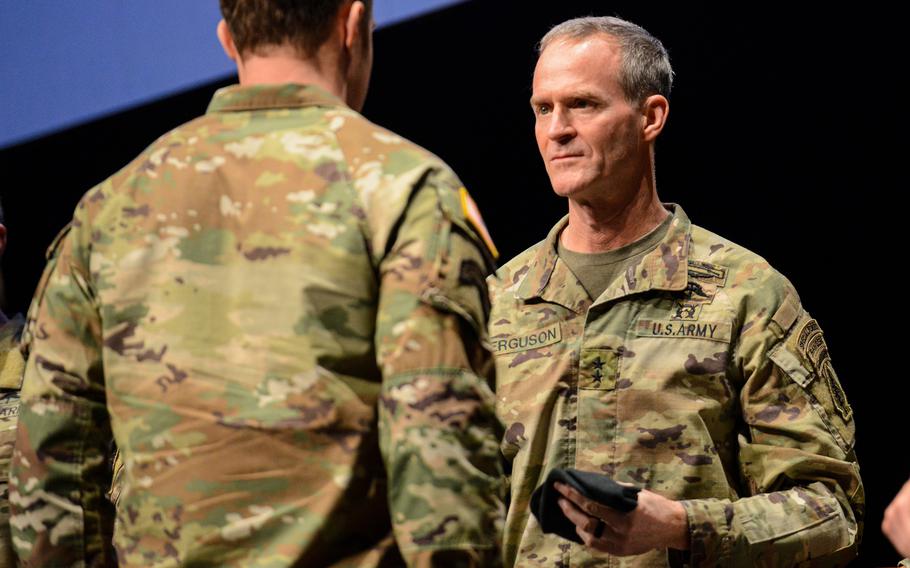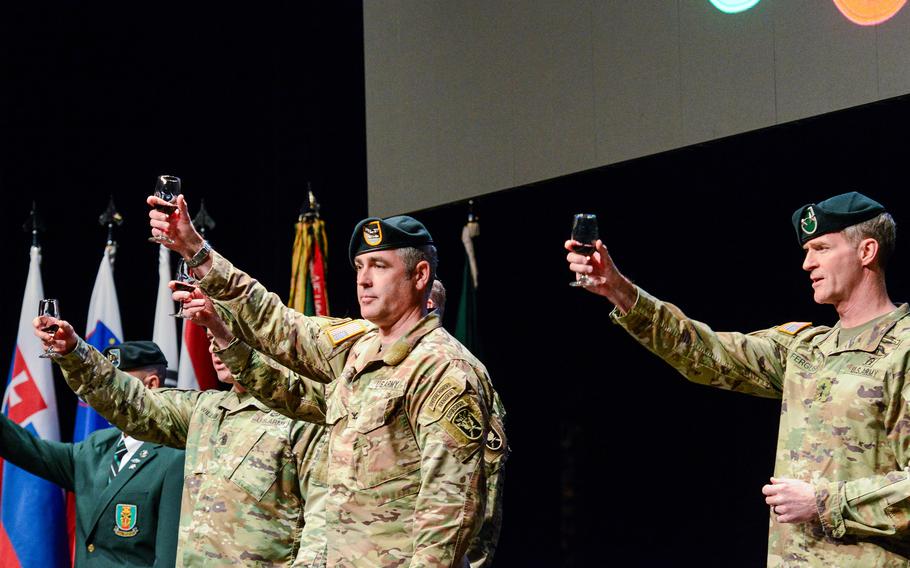
New Special Forces soldiers don their Green Berets for the first time during their Special Forces Qualification Course graduation on Jan. 23, 2025, in Fayetteville, N.C. (Corey Dickstein/Stars and Stripes)
FAYETTEVILLE, N.C. — The Army’s 157 newest Special Forces soldiers for the first time donned their iconic Green Berets before a crowd of cheering family and friends packed into the city’s Crown Theatre last month.
For those elite soldiers soon traveling to Special Forces operational detachments across the force, the moment highlighted their Jan. 23 graduation from the intensive, monthslong qualification course at the John F. Kennedy Special Warfare Center and School at nearby Fort Liberty. The time-honored graduation ceremony is known in the Special Forces community as the Regimental First Formation, marking the soldiers’ entrance into the ranks of the Special Forces regiment and their right to wear the coveted green headgear and Special Forces tab that identify them as members of that elite organization.
“The Green Beret at the end of the day is a piece of fabric that you wear on your head, but it symbolizes something much, much deeper,” said Col. Dave Lucas, who commands the 4th Battalion, 1st Special Warfare Training Group, which runs the Special Forces Qualification Course for SWCS. “I’m sure they’ve tried on the berets at home and whatnot, but now they actually get to wear it. And that means something … because of the trials that they’ve been through to earn it, but it really means something because of all the people who went before them and what those generations did to make it what it is.”
The Army’s Special Forces traces its lineage to the 1950s, and the iconic Green Beret was officially authorized for the elite soldiers in 1962 by then-President Kennedy. Green Berets have since become a critical special operations force tasked with conducting sensitive missions around the globe — often focused on working hand-in-hand with indigenous forces to fight with limited U.S. forces and resources. In the weeks after the al-Qaida attacks on 9/11, it was Green Berets who were first sent into Afghanistan on a mission to link with Afghan fighters to attack the Taliban in the opening days of Operation Enduring Freedom.
To enter the ranks of the Green Berets, soldiers must complete the grueling, three-week Special Forces Assessment and Selection course and then pass the Special Forces Qualification Course, or Q Course, which can range from some 50 weeks to almost two years of training, according to the service.
Though the Army in recent years has considered deep cuts to its special operations formations that expanded dramatically during the post-9/11 wars, Special Operations officials have said the demands for Green Berets have not declined, even as the wars in Afghanistan and Iraq have wound down. President Donald Trump’s administration has not made public its plans for the future of special operations forces since his return to the White House last month, and officials at the Pentagon declined to comment on any impending changes to force structure.
Regardless of any changes to come, one of SWCS primary roles is to keep pushing qualified young men and women through the Special Forces training pipeline to ensure units have enough Green Berets to conduct missions, said Command Sgt. Maj. Lionel Strong, the senior enlisted leader for SWCS.
Strong, who earned his Green Beret in 2002 and has served with Special Forces units on numerous deployments in Iraq and Afghanistan, said in order to keep those units fully staffed, SWCS needs more soldiers attempting Special Forces training than have done so in recent years.
Recruiting shortfalls across the entire Army and flat Special Operations budgets that have failed to keep up with inflation have contributed to a smaller-than-ideal number of Special Forces hopefuls entering training courses, officials said. Nonetheless, Strong said, the special warfare school has managed to produce enough Green Berets to maintain a Special Forces community that is “healthy enough now to conduct the operations on behalf of the nation.”
“That being said, we do have to put in some effort into identifying, recruiting and prepare the next generation of [Army Special Operations] soldiers,” he said.
For Lucas, who earned his Green Beret in 2009 after serving previously in another Army special operations outfit, the 75th Ranger Regiment, the pitch to today’s young soldiers to try out for Special Forces is simple: “Don’t limit yourself. Give it a shot,” he said.
“You never know until you try. I’ve met a lot of people over the years that … were going to do this and going to do that, and I’d say, ‘Don’t look back and say that. Give it a shot because you never know,’” the colonel said. “The worst-case scenario is [you don’t pass Special Forces training and] you’re still in the Army, but you never know, it may work out, and you can find yourself having more fun than you ever anticipated.”
Making Green Berets
Training to enter the Special Forces is difficult by design, according to Strong. It is meant to ensure Green Beret units are filled with elite, capable troops with the ability to adapt to difficult and stressful situations.
The first course, SFAS, is meant to weed out those who do not display the traits necessary to succeed in the Special Forces -- high physical fitness levels, intelligence and personal character, Strong said.
“Your intelligence and your fitness, we have tools and resources to help with that, but the thing that I would say is foundational to us is character,” the command sergeant major said. “We’ve got to know that a person we’re bringing [into Special Forces] has the shared values, beliefs and behaviors with our organization and the Army.”
The highly intensive, three-week SFAS course includes fitness tests, long marches carrying heavy loads, land navigation challenges, obstacle courses, and cognitive tests sometimes conducted with little-to-no sleep, according to the Army. SWCS officials declined to provide a recent estimate of the percentage of soldiers who successfully complete the SFAS course, but a 2019 study published by the U.S. Army Research Institute indicated only about 31% of SFAS participants were selected that year to move on to the Q Course.
The Q Course has a much higher success rate, Strong said, with some 80% to 90% completing it on their first try.
Once accepted into the Q Course, soldiers enter the lengthy pipeline that turns them into experts in their chosen Special Forces craft, Lucas said. Those soldiers spend part of the course training with their comrades. In other parts, they split into unique courses to train them to conduct their selected specialty. Those Special Forces specialties include weapons, engineering, communications and combat medicine for enlisted soldiers. Officers and warrant officers train to learn their jobs in Special Forces in separate courses within the Q course.
During the course of about a year, Green Beret hopefuls learn small unit tactics, how to use foreign weapons systems, train in irregular warfare techniques, learn foreign language skills, complete the Survival, Evasion, Resistance and Escape course, and operate in the two-week culmination exercise known as Robin Sage, in which Special Forces candidates test the skills that they learned throughout the course.
When they have completed all that training, Lucas said, they have almost certainly proved themselves as capable, adaptable and creative soldiers ready to serve in the 12-man operational detachments that form the foundations of Special Forces units.

Army Maj. Gen. Gil Ferguson, commander of the 1st Special Forces Command at Fort Liberty, N.C., hands a new Special Forces soldier his Green Beret at a graduation ceremony Jan. 23, 2025, for those who recently completed the Special Forces Qualification Course. (Corey Dickstein/Stars and Stripes)
‘It won’t be boring’
As the latest group of new Green Berets — Q Course class 338 — gathered Jan. 23 inside Fayetteville’s Crown Complex, where generations of Special Forces soldiers have first donned their earned headgear, Lucas told them he could not predict what their futures would hold.
“Nobody has any idea what’s in store for them ahead,” he said. “I don’t know where their careers are going to take them, and neither do [they]. But I can promise you one thing, it won’t be boring.”
For Lucas, his 28 years in the Army have included assignments in Georgia, North Carolina, New York, Kentucky, Washington, D.C., and at least eight combat tours in Iraq, according to his official biography.
As a captain leading a Special Forces operational detachment from the Fort Campbell, Ky.-based 5th Special Forces Group on lengthy tours in Iraq have been among the highlights during his career, he said. The new Green Berets could find themselves almost anywhere in the world, as Special Forces teams continue to deploy to train or operate in countries across the globe.
“I’ve gotten to do things that I’d never, ever, ever thought I would do,” Lucas said. “You’re truly empowered here, like you are in very, very few other places … across the Army.”
For Strong, his 23 years in Special Forces have taken him across Afghanistan, the Middle East, Africa, South America and Asia. Like Lucas, he said he could not predict where the latest crop of Green Berets might serve, but he promised they would continue to be called upon for decades to come.
“At some point our nation might need to do something that is high risk, time constrained and politically sensitive, and if not one, maybe all three of those things at once, and generally, special operations forces are better suited to do those kinds of missions,” he said. “Special Forces — we’re going to be there at every phase of the operations form shaping, to conflict and back … [and] we’re going to work by, with and through our partner forces … building partnership capacity in those relationships, and we’re probably going to have unconventional solutions to complex problems.”
“If anything, the demand [for Green Berets] is going up.”

Senior Green Berets — including Maj. Gen. Gil Ferguson, commander of the 1st Special Forces Command at Fort Liberty, N.C., right, and Col. Dave Lucas, commander of the 4th Battalion, 1st Special Warfare Training Battalion, center — toast 157 new Army Special Force soldiers during a graduation ceremony Jan. 23, 2025, for those who recently completed the Special Forces Qualification Course. The monthslong course run by the John F. Kennedy Special Warfare Center and School at the Army base prepares new Green Berets to operate in Special Forces units. (Corey Dickstein/Stars and Stripes)